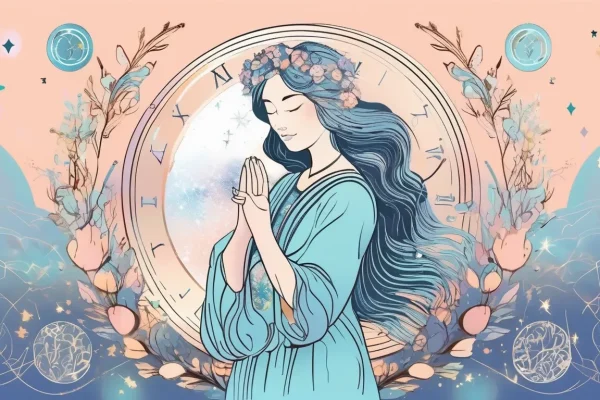 Spiritual dream interpretation is a beautiful and profound way of understanding the messages that our subconscious and higher self are trying to communicate to us. It is a means of unlocking the hidden wisdom and guidance that is embedded within our dreams.
Spiritual dream interpretation is a beautiful and profound way of understanding the messages that our subconscious and higher self are trying to communicate to us. It is a means of unlocking the hidden wisdom and guidance that is embedded within our dreams.
Understanding spiritual dreams is essential to our spiritual growth and overall well-being. Dreams can serve as a mirror of our innermost desires, fears, and emotions. They can provide insight into our deepest hopes and aspirations, as well as reveal hidden aspects of ourselves that we may not be aware of.
Interpreting spiritual dreams involves examining the symbols, characters, and themes that appear in our dreams. It involves exploring the meanings behind these elements and deciphering their significance in the context of our lives.
By interpreting our spiritual dreams, we can gain a deeper understanding of ourselves and our life’s purpose. We can uncover our true passions, overcome our fears, and navigate the challenges of life with greater clarity and wisdom.
So, if you’re ready to unlock the hidden messages within your dreams and gain a greater understanding of yourself and your life’s purpose, then delve into the world of spiritual dream interpretation today!
Understanding Dreams
What are Dreams?
Dreams are one of the most mysterious and fascinating aspects of the human experience. They are a window into our subconscious mind and provide a glimpse into the deepest aspects of ourselves.
Types of Dreams
There are many different types of dreams, each with their own unique characteristics and meanings. Some dreams are vivid and lifelike, while others are hazy and fragmented. Some dreams are full of symbolism and hidden meanings, while others are straightforward and easy to interpret.
The Science of Dreams
Despite their mystery, science has made some fascinating discoveries about dreams. Researchers have found that dreams are essential for our overall well-being and mental health. During sleep, our brains process and consolidate memories, emotions, and experiences, allowing us to better navigate the challenges of life.
Furthermore, scientists have discovered that dreams are not limited to just humans. Animals, too, experience dreams and go through similar processes of memory consolidation and emotional processing during sleep.
Overall, dreams are a fascinating and integral part of our human experience. They offer us a glimpse into our deepest selves and provide us with essential insights into our inner world. So, whether you’re experiencing a vivid, fantastical dream or a fragmented, hazy one, embrace the mystery and allow yourself to explore the depths of your subconscious mind.
The Spiritual Side of Dreams
Dreams in Different Cultures
Dreams have played a significant role in various cultures throughout history, offering people from different backgrounds a unique and personal connection to the spiritual realm.
In some cultures, dreams are considered a form of divination, offering insight and guidance from the gods. In others, dreams are viewed as a means of communication between the living and the dead, allowing individuals to connect with departed loved ones.
Dreams in Religion
Many religions also place great importance on dreams, with religious texts and teachings often referencing dreams as a means of receiving divine guidance and inspiration. For example, in Islam, it is believed that dreams are one of the 45 sources of divine guidance.
Dreams in Mysticism
Mysticism is another area where dreams are highly regarded. Many mystics believe that dreams offer a direct pathway to the divine, allowing individuals to connect with the spiritual realm in a deeply personal and profound way.
Whether viewed as a tool for divination, a means of communicating with the deceased, or a pathway to the divine, dreams have played a vital role in the spiritual practices of various cultures and religions throughout history.
So, if you find yourself struggling to connect with your spirituality or seeking deeper insight into your spiritual journey, perhaps turning to your dreams may offer a unique and personal pathway toward greater understanding and connection with the spiritual realm.
Symbolism in Dreams
Meaning of Common Dream Symbols
Dream symbols are like puzzle pieces, each with its own unique meaning and significance. By understanding the symbolism behind common dream elements, we can gain greater insight into our subconscious mind and the messages our dreams are trying to communicate.
Interpretation of Colors, Numbers, and Shapes in Dreams
Colors, numbers, and shapes are common dream symbols that can provide valuable insight into the meaning of our dreams. For example, the color red may represent passion or anger, while the number three may signify completion or wholeness. Shapes, too, can hold significant meaning, with circles representing unity and completion, and triangles representing strength and stability.
Interpretation of Colors, Numbers, and Shapes in Dreams
Dream characters and actions are also essential elements to consider when interpreting our dreams. The people who appear in our dreams may represent different aspects of ourselves or symbolize important people in our lives. The actions that take place in our dreams may reflect our deepest desires, fears, or unresolved emotions.
By examining the symbolism of common dream elements and considering the significance of dream characters and actions, we can unlock the hidden messages within our dreams and gain a deeper understanding of ourselves and our subconscious mind.
So, the next time you wake up from a dream, take a moment to reflect on the symbols, characters, and actions that appeared. Ask yourself what they may represent or symbolize in your life. Allow yourself to delve deeper into the hidden messages within your dreams and embrace the wisdom and insight that they have to offer.
Different Approaches to Spiritual Dream Interpretation
Dream interpretation has been a subject of fascination and study for centuries, with different schools of thought and approaches to understanding the messages within our dreams.
Jungian Approach to Dream Interpretation
One such approach is the Jungian approach to dream interpretation, which emphasizes the symbolic meaning of dreams and their connection to our collective unconscious. Jung believed that dreams offer insights into our deepest fears, desires, and hidden aspects of ourselves, and that by examining the symbolism within our dreams, we can gain a greater understanding of our psyche.
Freudian Approach to Dream Interpretation
The Freudian approach to dream interpretation, on the other hand, focuses on the role of the unconscious in shaping our dreams. Freud believed that dreams represent repressed desires and emotions and that by analyzing the content of our dreams, we can gain insight into our unconscious mind.
Biblical Approach to Dream Interpretation
In the biblical approach to dream interpretation, dreams are viewed as a means of divine communication, with many biblical figures receiving important messages and guidance through their dreams. Biblical interpreters analyze the symbols and themes within dreams to uncover their hidden meanings and discern the divine messages they convey.
Shamanic Approach to Dream Interpretation
The shamanic approach to dream interpretation emphasizes the spiritual significance of dreams, viewing them as a means of connecting with the spiritual realm and accessing divine wisdom. Shamans use various techniques, such as lucid dreaming and dream incubation, to harness the power of dreams and gain greater insight into their spiritual journeys.
Overall, these different approaches to dream interpretation offer unique insights into the messages within our dreams and the various ways in which they can be interpreted and understood. By exploring these different approaches, we can gain a deeper appreciation for the mysteries and wisdom within our dreams.
Techniques for Spiritual Dream Interpretation
Journaling Your Dreams
To truly unlock the power of your dreams and spiritual journey, it’s important to embrace practices that can help you cultivate deeper awareness and connection with your inner self. Journaling your dreams is a powerful tool that can help you remember and analyze the messages and symbols that appear in your dreams. By keeping a dream journal by your bed and reflecting on your dreams regularly, you can gain valuable insights into your subconscious mind and begin to unravel the mysteries of your inner world.
Lucid Dreaming
Another powerful tool for exploring your dreams and spiritual journey is lucid dreaming. By learning to recognize when you’re dreaming and then taking control of your dreams, you can actively shape your experiences and explore your inner world with greater intention and awareness. This can be a thrilling and transformative practice that can help you unlock new levels of insight and creativity.
Meditation
Meditation is another powerful tool for deepening your spiritual connection and exploring the mysteries of your inner world. By practicing meditation regularly, you can quiet your mind, cultivate inner stillness and focus, and develop a greater sense of awareness and intuition. This can be a powerful complement to dream analysis, helping you connect more deeply with your inner wisdom and guidance.
Affirmations and Visualizations
Affirmations and visualizations are also powerful tools for shaping your inner world and cultivating a deeper connection with your spiritual journey. By repeating positive affirmations and visualizing positive outcomes, you can train your mind to focus on the things you want to create in your life and develop a greater sense of inner strength, courage, and resilience.
So whether you choose to explore your dreams through journaling, lucid dreaming, meditation, affirmations, or a combination of these practices, the important thing is to stay committed to your journey, embrace the mysteries of your inner world with open hearts and minds, and never stop seeking new insights and inspiration. The possibilities are endless, and the rewards are infinite.
Common Themes in Spiritual Dreams
Death and Rebirth
Some dreams are so powerful that they stay with us long after we wake up. Dreams of death and rebirth, for example, can be both terrifying and transformative, representing a profound shift in our lives and our understanding of ourselves.
Water and Its Symbolism
Water is another powerful symbol in dreams, representing the ebb and flow of our emotions and the deep well of our subconscious mind. Calm waters may represent inner peace and tranquility, while turbulent waters may represent inner turmoil and emotional upheaval.
Falling Dreams and Their Interpretation
Falling dreams can be particularly unsettling, evoking feelings of fear and vulnerability. However, they can also represent a sense of surrender and letting go, as we release control and trust in the journey ahead.
Chasing Dreams and Their Interpretation
Chasing dreams, on the other hand, can represent our pursuit of something that we desire, whether it be a personal goal or a deeper sense of purpose. These dreams may reveal our innermost desires and ambitions, and offer insights into what drives us in life.
Flying Dreams and Their Interpretation
Flying dreams are perhaps the most exhilarating of all, representing a sense of freedom and transcendence. These dreams may reveal our highest aspirations and our deepest sense of self, inviting us to explore the heights of our potential and the boundless possibilities of our imagination.
Ultimately, the meaning of our dreams is unique to each individual, shaped by our personal experiences, emotions, and beliefs. By delving deeper into the symbolism of our dreams and exploring the hidden messages within, we can gain a deeper understanding of ourselves and the journey of our souls.
Steps for Interpreting Your Spiritual Dreams
Dreams can be powerful messages from our subconscious, offering insights into our deepest desires, fears, and hopes for the future. When interpreting our dreams, it’s important to approach them with an open heart and mind, and to look for the key themes, symbols, and characters that emerge.
Identify the Main Theme
One of the first steps in interpreting our dreams is to identify the main theme or message. This may involve looking at the overall tone of the dream, as well as the emotions and experiences that are highlighted. By identifying the main theme, we can gain a greater understanding of the underlying messages within our dreams.
Analyze the Symbols and Characters
Another important aspect of dream interpretation is to analyze the symbols and characters that appear in our dreams. These may be people from our past, animals, or abstract symbols such as colors and shapes. By examining the meaning of these symbols, we can gain a deeper understanding of the hidden messages within our dreams.
Connect the Dream with Your Life
Connecting the dream with our own lives is another important step in dream interpretation. This may involve reflecting on our own personal experiences and emotions, and looking for connections between the dream and our waking lives. By doing so, we can gain greater insight into the messages that our dreams are trying to convey.
Look for Messages from Your Higher Self
Finally, it’s important to look for messages from our higher selves when interpreting our dreams. These messages may come in the form of intuitive insights, spiritual guidance, or a deeper sense of purpose and meaning in our lives. By tuning into these messages, we can gain a greater sense of clarity and direction, and a deeper connection to our true selves.
In essence, dream interpretation is an invitation to explore the mysteries of our inner selves and the journey of our souls. By embracing this process with an open heart and mind, we can gain a greater understanding of ourselves and the infinite possibilities that exist within us.
FAQs on Spiritual Dream Interpretation
Dreams have captivated human minds for centuries, and as such, it’s natural to have questions about their meaning, power, and potential. Here are some common questions about spiritual dream interpretation, and answers that may help you better understand your own dreams and inner journey.
Question: How can I remember my dreams?
Remembering your dreams can be challenging, but there are some simple techniques that can help. Setting the intention to remember your dreams before going to sleep, keeping a dream journal by your bed, and reflecting on your dreams as soon as you wake up can all help to improve dream recall.
Question: Can dreams predict the future?
While some people believe that dreams can predict the future, there is no scientific evidence to support this claim. However, dreams can offer powerful insights into our own inner selves and may provide guidance for our waking lives.
Question: What if I have recurring dreams?
Recurring dreams can be a sign that your subconscious is trying to tell you something important. Analyzing the symbols, characters, and emotions that appear in these dreams can help you gain a deeper understanding of their meaning and significance.
Question: Can I learn to control my dreams?
Lucid dreaming is a technique that allows you to become aware that you are dreaming while you are still in the dream state. With practice, you may be able to learn to control your dreams and explore the depths of your own subconscious mind.
Question: What if I have nightmares?
Nightmares can be distressing, but they can also offer important insights into our deepest fears and anxieties. Analyzing the symbols and characters that appear in these dreams and reflecting on their possible meaning can help us better understand and heal our inner selves.
In the end, dream interpretation is a deeply personal and subjective journey. By embracing the mystery and magic of our dreams, we can gain a deeper understanding of ourselves and the infinite potential that exists within us.
Conclusion
As we’ve explored the rich and complex world of spiritual dream interpretation, we’ve discovered a vast array of symbols, archetypes, and insights that can help us unlock the secrets of our own subconscious minds.
To recap, we’ve covered the basics of dream analysis, including the importance of understanding dreams, the different types of dreams, and the scientific and cultural perspectives on dreaming. We’ve also delved into the powerful symbols and archetypes that often appear in dreams, including death and rebirth, water, falling, chasing, and flying.
We’ve explored different approaches to dream interpretation, from the analytical frameworks of Jung and Freud to the spiritual and religious interpretations found in biblical and shamanic traditions. And we’ve learned how to apply these insights to our own dreams, looking for connections to our waking lives, analyzing symbols and characters, and searching for messages from our higher selves.
In conclusion, the world of spiritual dream interpretation is a vast and fascinating one, full of mystery, symbolism, and potential. By embracing our dreams and learning to interpret them with open hearts and minds, we can gain a deeper understanding of ourselves and our place in the universe.
So let us all take action and commit to exploring the world of our dreams with curiosity, wonder, and a spirit of adventure. Keep a dream journal by your bed, reflect on your dreams, and seek out resources and insights that can help you unlock the secrets of your inner self. The journey may not always be easy, but the rewards are infinite and the potential for growth and transformation is limitless.
Exploring the Depths of Your Soul: The Profound Spiritual Meaning of Dreaming About Your Ex
The Spiritual Meaning of Dreams About Babies: Divine Messages in the Night
Spiritual meaning of dreams about cheating: What Your Soul Is Trying to Tell You
The Mystical Meaning of Teeth Falling Out in Your Dreams: A Spiritual Guide
The Soul-Searching Guide to Understanding the Spiritual Meaning of Hair Loss in Dreams




